
The word catholic comes from the Greek phrase καθόλου katholou 'on the whole, according to the whole, in general', and is a combination of the Greek words κατά 'about' and ὅλος 'whole'. The first use of "Catholic" was by the church father Saint Ignatius of Antioch in his Letter to the Smyrnaeans. In the context of Christian ecclesiology, it has a rich history and several usages.
Anathema, in common usage, is something or someone detested or shunned. In its other main usage, it is a formal excommunication. The latter meaning, its ecclesiastical sense, is based on New Testament usage. In the Old Testament, anathema was a creature or object set apart for sacrificial offering and thus removed from ordinary use and destined instead for destruction.

The Counter-Reformation, also called the Catholic Reformation or the Catholic Revival, was the period of Catholic resurgence that was initiated in response to the Protestant Reformation, also known as the Protestant Revolution. It began with the Council of Trent (1545–1563) and largely ended with the conclusion of the European wars of religion in 1648. Initiated to address the effects of the Protestant Reformation, the Counter-Reformation was a comprehensive effort composed of apologetic and polemical documents and ecclesiastical configuration as decreed by the Council of Trent. The last of these included the efforts of Imperial Diets of the Holy Roman Empire, heresy trials and the Inquisition, anti-corruption efforts, spiritual movements, and the founding of new religious orders. Such policies had long-lasting effects in European history with exiles of Protestants continuing until the 1781 Patent of Toleration, although smaller expulsions took place in the 19th century.

Eutychius, considered a saint in the Catholic and Eastern Orthodox Christian traditions, was the patriarch of Constantinople from 552 to 565, and from 577 to 582. His feast is kept by the Orthodox Church on 6 April, and he is mentioned in the Catholic Church's "Corpus Juris". His terms of office, occurring during the reign of Emperor Justinian the Great, were marked by controversies with both imperial and papal authority.

Saint Joseph's Prairie Church is a former Catholic parish of the Archdiocese of Dubuque. The parish was located in Washington Township, Dubuque County, Iowa - which is about ten miles south of Dubuque.
Profanity in Finnish is used in the form of intensifiers, adjectives, adverbs and particles. There is also an aggressive mood that involves omission of the negative verb ei while implying its meaning with a swear word.

Venezuelan Spanish refers to the Spanish spoken in Venezuela.
Subsistit in is a Latin phrase which appears in Lumen gentium, the fundamental document on the church from the Second Vatican Council of the Catholic Church. Since the Council the reason for use of the term "subsists in" rather than simply “is” has been disputed. Generally, those who see little or no change in church teaching in Vatican II insist on the equivalence of subsistit in and “is”. Those who point to a new, ecumenical thrust in Vatican II insist that the term was introduced as a compromise after much discussion, and acknowledges new elements in the Council's teaching.
Sacred describes something that is dedicated or set apart for the service or worship of a deity; is considered worthy of spiritual respect or devotion; or inspires awe or reverence among believers. The property is often ascribed to objects, or places.
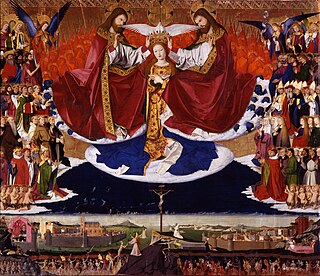
Catholic art is art produced by or for members of the Catholic Church. This includes visual art (iconography), sculpture, decorative arts, applied arts, and architecture. In a broader sense, Catholic music and other art may be included as well. Expressions of art may or may not attempt to illustrate, supplement and portray in tangible form Catholic teaching. Catholic art has played a leading role in the history and development of Western art since at least the 4th century. The principal subject matter of Catholic art has been the life and times of Jesus Christ, along with people associated with him, including his disciples, the saints, and motifs from the Catholic Bible.

The Immaculate Conception Roman Catholic Church is located at Front and Allen Streets in Philadelphia, PA 19123 in the Northern Liberties, Philadelphia, Pennsylvania section of the city; after over 140 years as an independent parish, it became a worship site of the adjacent St. Michael's parish in 2011. The parish celebrated its 150th anniversary in 2019, having been founded in 1869 under the leadership of Bishop James Frederick Wood. Twenty-five years earlier, two Catholic parishes within about a mile of the church—St. Augustine Church, Philadelphia at 4th and Vine and St. Michael at 2nd and Jefferson—were burnt to the ground in violent anti-Catholic nativist riots. The church continued as an independent parish or as a worship site for almost 150 years until, in the fall of 2019, it was announced that the church building would be closed permanently.
The Chapel of St. Patrick was a mission church under the authority of the Roman Catholic Archdiocese of New York, located in Millerton, Dutchess County, New York. It was founded in 1867.

Saint Casimir Church is a Catholic parish church in Cleveland, Ohio, and part of the Roman Catholic Diocese of Cleveland. It is designated "a personal parish for those Catholics of the Latin Rite of Polish descent" in Cleveland. A personal parish is designated under Canon 518 of the 1983 Code of Canon Law. It is located at the north-east corner of intersection of East 82nd St. and Sowiniski Ave., in a part of the St. Clair-Superior neighborhood previously known in Polish as na Poznaniu.
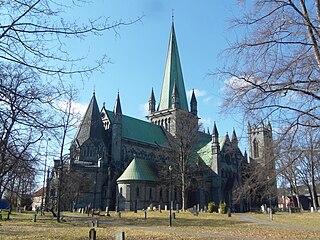
Church building in Norway began when Christianity was established there around the year 1000. The first buildings may have been post churches erected in the 10th or 11th century, but the evidence is inconclusive. For instance under Urnes Stave Church and Lom Stave Church there are traces of older post churches. Post churches were later replaced by the more durable stave churches. About 1,300 churches were built during the 12th and 13th centuries in what was Norway's first building boom. A total of about 3,000 churches have been built in Norway, although nearly half of them have perished. From 1620 systematic records and accounts were kept although sources prior to 1620 are fragmented. Evidence about early and medieval churches is partly archaeological. The "long church" is the most common type of church in Norway. There are about 1620 buildings recognized as churches affiliated with the Church of Norway. In addition, there are a number of gospel halls belonging to the lay movement affiliated with the Church of Norway as well as churches belonging to other Christian bodies. Until the 20th century, most churches were built from wood. 220 buildings are protected by law, and an additional 765 are listed as valuable cultural heritage.
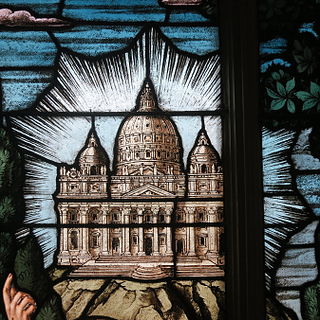
Catholic ecclesiology is the theological study of the Catholic Church, its nature and organization, as described in revelation or in philosophy. Such study shows a progressive development over time. Here the focus is on the time leading into and since the Second Vatican Council (1962–1965).

The Parish of St. Ann-St. Brendan is a parish of the Archdiocese of New York located in the Bronx, New York. It was created on August 1, 2015, by the merger of two previous parishes, the Shrine Church of St. Ann and the Parish of St. Brendan.
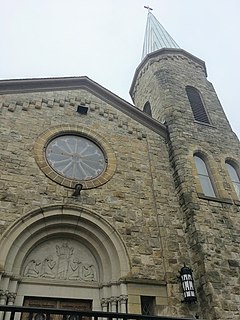
Sacred Heart Church, or the Church of the Sacred Heart, as it was officially known, was a Roman Catholic church located at 40 South Irvine Avenue in Sharon, Pennsylvania. It was a part of the Diocese of Erie.
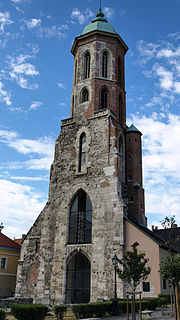
The Church of Mary Magdalene of Buda is one of the oldest churches of the Várkerület District. Dedicated to Jesus' follower, Mary Magdalene, it was built between the 13th and 15th centuries in Gothic style. Today only ruins and the tower of the church remains.

Holy Trinity Church is a historic church building and former parish of the Catholic Church located in the Society Hill neighborhood of Philadelphia, Pennsylvania. Established in 1784, the church was a national parish for Germans and was the first national parish for any ethnicity in the United States. The church merged with St. Mary's Church in 2009 and closed in 2019.

St Giles' Church in the historical centre of the city of Erfurt in Thuringia, Germany, forms the eastern entrance from Wenigemarkt to the Krämerbrücke with its archway. The single-nave Gothic church building is one of the former two bridgehead churches. At the western end stood the Benediktikirche since the 11th century, which was demolished in 1890 and is now only remembered by the name of Benediktsplatz.















